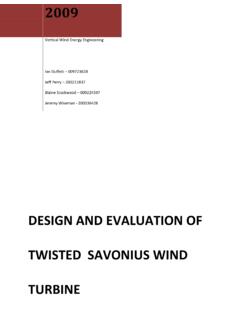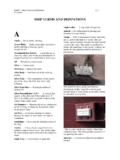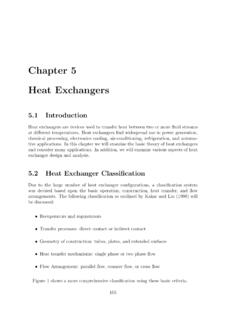Transcription of JavaCC Tutorial - Faculty of Engineering and Applied Science
1 Chapter 1 Introduction to JavaCC and Parser GenerationJavaCC is a parser generator and a lexical analyzer generator. Parsers and lexical analysersare software components for dealing with input of character sequences. Compilers andinterpreters incorporate lexical analysers and parsers to decipher files containing programs,however lexical analysers and parsers can be used in a wide variety of other applications,as I hope the examples in this boo kwill what are lexical analysers and parsers? Lexical analysers can brea ka sequence ofcharacters into a subsequences calledtokensand it also classifies the tokens.
2 Consider ashort program in the C programming main(){return 0 ;}The lexical analyser of a C compiler would brea kthis into the following sequence of to kens int , , main , ( , ) , , { , \n , \t , return , 0 , , ; , \n , } , \n , .The lexical analyser also identifies thekindof each token; in our example the sequence of2token kinds might beKWINT, SPACE, ID, OPAR, CPAR,SPACE, OBRACE, SPACE, SPACE, KWRETURN,SPACE, OCTALCONST, SPACE, SEMICOLON, SPACE,CBRACE, SPACE, EOF .The token of kind EOF represents the end of the original file. The sequence of tokens isthen passed on to the parser.
3 In the case of C, the parser does not need all the tokens;in our example, those clasified as SPACE are not passed on to the parser. The parserthen analyses the sequence of tokens to determine the structure of the program. Often incompilers, the parser outputs a tree representing the structure of the program. This treethen serves as an input to components of the compiler responsible for analysis and codegeneration. Consider a single statement in a programfahrenheit = + * celcius / ; .The parser analyzes the statement according to the rules of the language and produces atreeDIAGRAM TBDThe lexical analyser and parser also are responsible for generating error messages, if theinput does not conform to the lexical or syntactic rules of the itself is not a parser or a lexical anaylzer but agenerator.
4 This means thatit outputs lexical analyzers and parser according to a specification that it reads in from afile. JavaCC produces lexical analysers and parsers written in Java. See Figure TBDDIAGRAM TBDP arsers and lexical analysers tend to be long and complex components. A softwareengineer writing an efficient lexical analyser or parser directly in Java has to carefullyconsider the interactions between rules. For example in a lexical analyser for C, the codefor dealing with integer constants and floating-point constants can not be sperated, since afloating constant starts off the same as a floating-point constant.
5 Using a parser generatorsuch as JavaCC , the rules for integer constants and floating-point constants are writtenseparately and the commonality between them is extracted during the generation increased modularity means that specification files are easier to write, read, andmodify compared with a hand-written Java programs. By using a parser generator likeJavaCC, the software engineer can save a lot of time and produce software components ofbetter A first example adding integersAs a first example we ll add lists of numbers such as the following99+42+0+15.
6 We ll allow spaces and line breaks anywhere except within numbers. Otherwise the onlycharacters in the input must be the 10 digits or the plus the rest of this section the code examples will be parts of one file called .This file contains the JavaCC specification for the parser and the lexical analyser and willbe used as input to JavaCC the Options and class declarationThe first part of the file is/* Adding up numbers */options{STATIC = false ;}PARSERBEGIN(Adder)class Adder{static void main( String[] args )throws ParseException, TokenMgrError{Adder parser = new Adder( ) ; () ;}}PARSEREND(Adder)After an initial comment is a section for options.
7 All the standard values for JavaCC soptions are fine for this example, except for the STATIC option, which defaults to information about the options can be found in the JavaCC documentation, later inthis book, and in the FAQ. Next comes a fragment of a Java class namedAdder. What yousee here is not the completeAdderclass; JavaCC will add declarations to this class as partof the generation process. The main method is declared to potentially throw two classes ofexceptions:ParseExceptionandTokenMgrEr ror; these classes will be generated by Specifying a lexical analyserWe ll return to the main method later, but now let s loo kat the specification of the lexicalanalyser.
8 In this simple example, the lexical analyzer can be specified in only four lines4 SKIP :{ }SKIP :{ \n | \r | \r\n }TOKEN :{<PLUS : + >}TOKEN :{<NUMBER : ([ 0 - 9 ])+>}The first line says that space characters constitute tokens, but are to be skipped, that is,they are not to be passed on to the parser. The second line says the same thing aboutline breaks. Different operating systems represent line breaks with different charactersequences; in Unix and Linux, a newline character ( \n ) is used, in DOS and Windows acarriage return ( \r ) followed by a newline is used, and in older Macintoshes a carriagereturn alone is used.
9 We tell JavaCC about all these possibilities, separating them witha vertical bar. The third line tells JavaCC that a plus sign alone is a token and gives asymbolic name to this kind of token:PLUS. Finally the fourth line tells JavaCC aboutthe syntax to be used for numbers and gives a symbolic name,NUMBER,tothiskindoftoken. If you are familiar with regular expressions in a language such as Perl or Java sregular expression package, then the specification ofNUMBER tokens will probably bedecipherable. We ll take a closer look at the regular expression([ 0 - 9 ])+.
10 The[ 0 - 9 ]part is a regular expression that matches any digit, that is, any character whoseunicode encoding is between that of 0 and that of 9. A regular expression of the form(x)+matches any sequence of one or more strings, each of which is matched by regularexpressionx. So the regular expression([ 0 - 9 ])+matches any sequence of one or moredigits. Each of these four lines is called aregular expression is one more kind of token that the generated lexical analyser can produce, thishas the symbolic nameEOFand represents the end of the input sequence.















